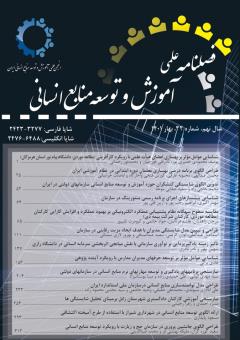تدوین الگوی شایستگی کنشگران حوزه آموزش و توسعه منابع انسانی در سازمانهای دولتی
محورهای موضوعی : شایستگی های مورد نیاز رهبران منابع انسانی
سعید صفایی موحد
1
![]() ,
محمد حاجی زاد
2
*
,
محمد حاجی زاد
2
*
1 - شرکت ملی نفت ایران
2 - گروه علوم تربیتی، واحد نکا، شرکت ملی نفت ایران، نکا، ایران
کلید واژه: شایستگیکارشناس آموزش سازمانهای دولتی,
چکیده مقاله :
هدف این پژوهش، شناسایی شایستگیهای مورد نیاز کارشناسان آموزش سازمانهای دولتی در ایران است. به این منظور ابتدا مدلهای شایستگی تدوین شده در سطح دنیا شناسایی شده و مولفههای مشترک آنها استخراج شدند. سپس از طریق بکارگیری روش دلفی و مصاحبه با متخصصان دانشگاهی و مسئولان آموزش سازمانهای دولتی(نمونهگیری هدفمند ملاکمحور) فهرستی از شایستگیها با توجه به ماموریت ادارات آموزش در این سازمانها استخراج شدند. جهت اعتباربخشی شایستگیها مدل تدوین شده سه نوبت در اختیار خبرگان مربوطه قرار گرفت تا نهایتا توافق لازم در مورد فهرست نهایی به دست آمد. بر طبق نتایج این تحقیق، شایستگیهای کارکنان آموزش را میتوان به دو دسته شایستگیهای پایه(ارتباط موثر، شناخت صنعت، سواد فنآوری، کلاننگری) و شایستگیهای تخصصی(تحلیل نیازهای آموزشی، طراحی آموزشی، روانشناسی یادگیری، راهبردهای آموزش و توسعه، سنجش یادگیری و عملکرد، تکنولوژی آموزشی، استانداردهای آموزش و توسعه) تقسیم نمود.
This study aims at identifying the necessary competencies for training advisors of Iranian state-run enterprises. Hence, international competency models were initially surveyed to agree over a list of common competencies. Then, related academics and training officials were interviewed through Delphi method to reach a unanimous consensus based on the requirements of state-run companies (purposeful criterion sampling). To establish credibility of the findings, the model was submitted to the related experts three times to reach consensus on the final model. Based on the findings, training competencies for state-run enterprises may be categorized into foundational (effective communication, industry knowledge, technology industry, seeing the big picture) and technical (training needs analysis, instructional design, psychology of learning, training and development strategies, learning and performance assessment, learning technologies, training and development standards).
1. Sanghi, Seema (2016). The Handbook of Competency Mapping: Understanding, Designing and Implementing Competency Models in Organizations. London, SAGE Publications Pvt. Ltd
2. Biech, Elaine (2014). ASTD Handbook: The Definitive Reference for Training & Development. Alexandria, Association for Talent Development.
3. Galagan, Pat; Hirt, Morgean; Vital, Courtney, Vital (2019). Capabilities for Talent Development: Shaping the Future of the Profession. Alexandria, Association for Talent Development.
4. Valkeavaara, Tuija (1998). Human resource development roles and competencies in Five European countries. International of Training and Development. 7(3): 171-189.
5. Safaei Movahed, Saeed (2021). Training and development of human resources. Tehran: Science of Masters.
6. Safaei Movahed, Saeed; Falahinia, Hussein (2015). Development of a professional development plan for experts and training managers in the National Iranian Oil Company: A qualitative study. Quarterly Journal of Human Resources Education and Development. 3 (8): 122-97.
7. Safaei Movahed, Saeed; Falahinia, Hussein (2016). Develop a plan to train an expert training teacher for the Ministry of Oil based on the knowledge domain approach. Quarterly Journal of Human Resources Education and Development. 4 (13): 71-59.

